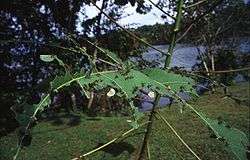Atta colombica
Atta colombica is one of 47 species of leafcutter ants. This species is part of the Attini tribe (the fungus-growing ants).
| Atta colombica | |
|---|---|
_05.jpg) | |
| Atta colombica carrying a leaf segment | |
| Scientific classification | |
| Kingdom: | |
| Phylum: | |
| Class: | |
| Order: | |
| Family: | |
| Subfamily: | |
| Tribe: | |
| Genus: | |
| Species: | A. colombica |
| Binomial name | |
| Atta colombica (Guérin-Méneville, 1844)[1] | |
Description
Workers of this species are maroon in colour, and are entirely matte, with no shiny spots.[1]
Distribution

This species ranges from Guatemala to Colombia,[1][2] and can also be found in Costa Rica.[1]
Nests
A. colombica produces visible refuse dumps of spent fungus on the surface. These dumps often take the form of large, conical mounds, and are located to the side of the main soil mounds. Lines of workers carry the spent fungus from the nest to the dumps. They deposit the grayish-white pellets at the peak of the mounds, which produces the conical shape. This behaviour is different from A. cephalotes, which deposit their refuse in subterranean dumps.[1]
The number of workers in a colony is estimated to be 1.0-2.5 million.[3]
Behavior
A colony of A. colombica harvests, on average, 85–470 kg (187–1,036 lb) of plant biomass per year (dry weight), meaning they harvest a leaf area of about 835–4,550 m2 (8,990–48,980 sq ft) annually.[4][5][6]
The average number of different active males in each colony is believed to be less than three. Due to the variation of shared paternity, though, colonies effectively contain two fathers.[7]
Unlike the majority of Atta spp., that respond to colony threats from other ants with many small worker ants, A. colombica appears to recruit majors, or soldiers, for defense.[8]
References
- "Formicidae: Atta colombica". Academic.evergreen.edu. October 8, 2003. Archived from the original on 2 October 2010. Retrieved August 19, 2010.
- "Species: Atta colombica". AntWeb. 2010-06-30. Retrieved 2010-08-19.
- Saes, N. B.; Forti, L. C.; Pereira-da-Silva, V.; Fowler, H. G. (1986). "Population dynamics of leaf-cutting ants: A brief review". Cite journal requires
|journal=(help) - Herz, Hubert; Beyschlag, Wolfram; Hölldobler, Berthold (2007). "Herbivory Rate of Leaf-Cutting Ants in a Tropical Moist Forest in Panama at the Population and Ecosystem Scales". Biotropica. 39 (4): 482–488. doi:10.1111/j.1744-7429.2007.00284.x. ISSN 1744-7429.
- Wirth, Rainer; Herz, Hubert; Ryel, Ronald J.; Beyschlag, Wolfram; Hölldobler, Bert (2003). Herbivory of Leaf-Cutting Ants: A Case Study on Atta colombica in the Tropical Rainforest of Panama. Ecological Studies. Berlin Heidelberg: Springer-Verlag. ISBN 9783540438960.
- Herz, Hubert; Beyschlag, Wolfram; Hölldobler, Berthold (2007). "Assessing Herbivory Rates of Leaf-Cutting Ant (Atta colombica) Colonies Through Short-Term Refuse Deposition Counts". Biotropica. 39 (4): 476–481. doi:10.1111/j.1744-7429.2007.00283.x. ISSN 1744-7429.
- Thorén, Peter; Boomsma, Jacobus J.; Fjerdingstad, Else J. (January 1998). "Multiple paternity in the leafcutter ant Atta colombica — a microsatellite DNA study". Heredity. 80 (1): 118–126. doi:10.1038/sj.hdy.6882470. ISSN 1365-2540.
- Powell, S.; Clark, E. (2004-11-01). "Combat between large derived societies: A subterranean army ant established as a predator of mature leaf-cutting ant colonies". Insectes Sociaux. 51 (4): 342–351. doi:10.1007/s00040-004-0752-2. ISSN 1420-9098.
Further reading
- M. A. Bowers & S. D. Porter (1981). "Effect of foraging distance on water content of substrates harvested by Atta columbica (Guerin)". Ecology. 62 (1): 273–275. doi:10.2307/1936686. JSTOR 1936686.
External links

- Kathryn M. Sullan, Catrina A. Lindgren & Abigail Adams (2006). "Resource preference and foraging efficiency in leaf-cutter (Atta columbica) ants" (PDF). Dartmouth Studies in Tropical Ecology. Dartmouth College. Archived from the original (PDF) on 2012-10-16. Retrieved 2010-08-19.
- Atta colombica minor workers tending to their fungus garden